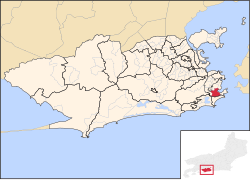Botafogo
| Botafogo | |
|---|---|
| Coordinates | 22 ° 57 ′ 0 ″ S , 43 ° 11 ′ 3 ″ W |

|
|
| Basic data | |
| Country | Brazil |
| Rio de Janeiro | |
| city | Rio de Janeiro |
| ISO 3166-2 | BR-RJ |
| Sub-prefecture | Zona Sul |
| surface | 4.8 km² |
| Residents | 95,583 (2010) |
| density | 19,917.3 Ew. / km² |

Botafogo is a district ( bairro ) of Rio de Janeiro , Brazil , which is located on the waterfront. The district is located between the hills of Mundo Novo , Santa Marta (which separates the district from Laranjeiras ) and Morro de São João (which separates it from Copacabana ). Mainly a middle class population of Rio de Janeiro lives there. It was named after João Pereira de Sousa Botafogo , who during the colonial period was the owner of the piece of land on which Botafogo is located today. The name literally means "set it on fire" and is related to the Italian surname Buttafuoco .
Botafogo Beach is located on Guanabara Bay , and is thus shielded from the Atlantic Ocean near the Urca Peninsula and the Sugar Loaf .
Botafogo has a high concentration of cafes, cinemas and theaters. Botafogo is also home to two of the city's largest shopping centers, Praia de Botafogo Shopping and Shopping RioSul . The district has international fame through the football club Botafogo FR .
The opera singer Bidu Sayão and the musician Carlos Lyra were also born in Botafogo .
This part of the city is also the patron saint of the samba dance step of the same name .
Together with the neighboring districts of Catete , Cosme Velho , Flamengo , Glória , Humaitá , Laranjeiras and Urca , Botafogo also forms the fourth district of the same name ( Região Administrativa ).
Attractions
- The childhood home of Ruy Barbosa
- The Museu do Índio - an Indian museum, which shows the cultural history of the indigenous population of Brazil.
- The Villa-Lobos Museum.

